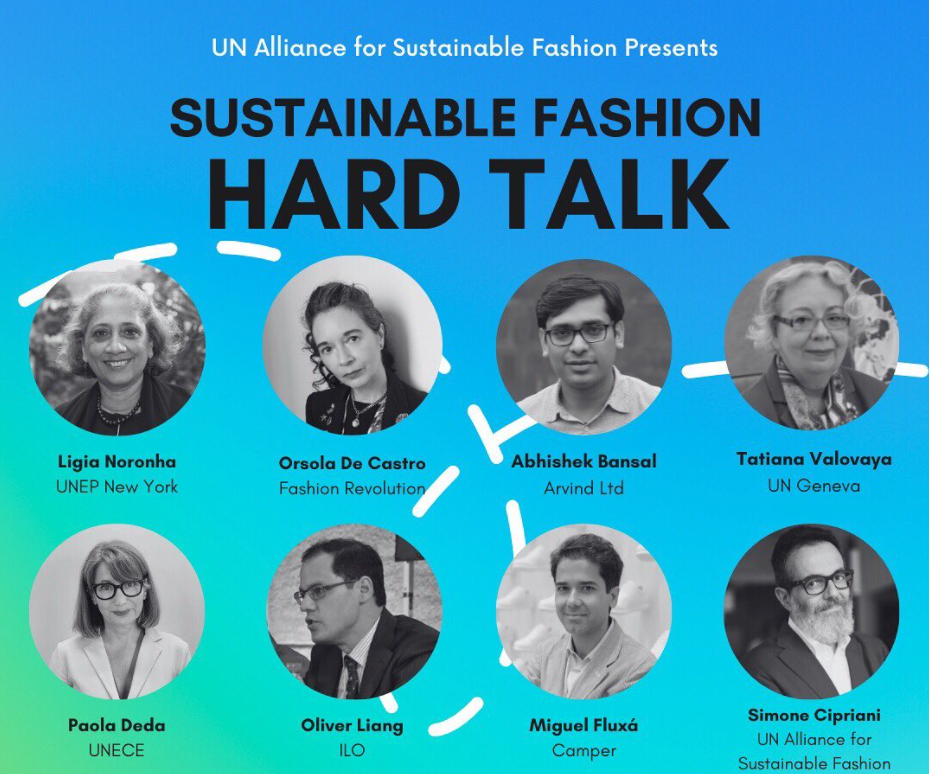
On July 7, 2021, against the backdrop of the UN’s High-level Political Forum on Sustainable Development (HLPF), the UN Alliance for Sustainable Fashion held a virtual discussion session tackling the fashion sector’s contributions to climate change while laying out approaches the industry can take to turn things around and become a driver of impactful global climate action.
The UN Alliance for Sustainable Fashion, launched in 2019 and composed of ten member organizations (Connect4Climate/World Bank among them), aims to harness the reach and creativity of fashion to help achieve the UN’s Sustainable Development Goals, finding avenues for meaningful action on both the labor side and the consumer side of the industry.
The Alliance’s live-streamed July 7 event, framed as a “Sustainable Fashion Hard Talk,” opened with remarks from UN Geneva Director-General Tatiana Valovaya, who called for a shift from the current model of wasteful fast fashion to one of sustainable “slow fashion” and emphasized the dual need for healthy working conditions and low environmental impact within the sector.
The session continued with inputs from an impressive array of speakers with experience in disparate facets of fashion, including: the International Labour Organization’s Oliver Liang; Ethical Fashion Initiative manager Simone Cipriani; fashion production representatives Abhishek Bansal (Arvind Limited, denims) and Miguel Fluxá (Camper, shoes); and sustainable fashion activist Orsola De Castro.
One of the first topics the group discussed was the definition of “sustainability” in the context of the fashion world. They decided that sustainable fashion means prioritizing the health of the environment over runaway profits and corporate growth, noting that attractive, commercially successful apparel needn’t be sacrificed so long as designs have long lifespans and are as widely accessible to consumers as possible. Fluxá expressed his wish for the growth of a culture of responsibility and long-term planning within the industry, while Bansal stressed the importance of zero-carbon targets. All agreed on the need for low-impact clothes produced under humane working conditions.
“There’s lots of hope with new technology that we can produce with a drastically lower impact,” Bansal offered. “We must do this!”
From here, the group explored the practicalities of sustainable fashion. De Castro doubled down on the themes of long-lived materials and accessibility to those in need, calling on the industry to embrace the moral obligations imposed by the climate crisis and global inequities. Cipriani expanded on this idea, exhorting fashion industry journalists to treat environmental impact and economic performance as equally important metrics of fashion houses’ success. He also emphasized the need for public-private partnerships and increased investment in the Global South. In terms of reducing waste, the group highlighted the need for improved distribution, robust recycling pipelines, and a cultural shift toward higher prices for more slowly developed but higher-quality clothes.
“We have to shift to less environmentally destructive products,” Liang urged. “Don’t be afraid!”
This notion of a cultural pivot drove the remainder of the group’s brainstorm. De Castro pointed to the lack of transparency in fashion as a major hindrance to sustainability-minded consumers and called for legislation-backed requirements that companies disclose the environmental consequences of their products. Bansal concurred, pointing out that regulations and standards can no longer be brushed aside as they have been in recent years, again emphasizing the need to raise the legislative bar to hold the industry accountable. De Castro concluded by saying that, as with all cultural shifts, this one will be driven in large measure by the ascendance of a new generation. She called on young people to stand up for sustainability and do their due diligence when shopping to spur the changes sorely needed in the business of fashion worldwide.
“We have to stop buying what we don’t need,” said Fluxá, “improve little by little.” “Don’t be afraid to start from your own wardrobe,” De Castro added. “Others will follow.”




